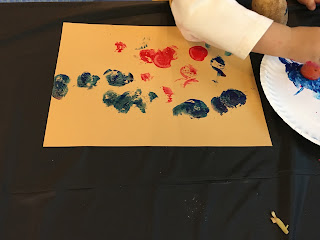Saturday was a bit snowy, as you can see looking out from our story room window below, but we did have a few brave families come in to join our celebration of "things that go 'round."
We talked about some of the round-shaped things we see every day and what things might go around (did someone say "the wheels on the bus?!").
Here's the plan:
Welcome song: "The Story Time Ball"
Tune: "Wheels on the Bus"
(Roll ball back and forth to each child)
The story time ball rolls back and forth,
back and forth, back and forth.
The story time ball rolls back and forth,
Let's see who it found. Hi ______!
Now roll it back to me.
(Keep rolling back and forth until each child has said their name.)
Mindfulness exercise: "Balloon breath"
(Mindfulness exercises and activities are great for helping with self-regulation, building focus and engaging with the world around you.)
Flannel rhyme: "Riding 'Round in my..."
(Tune: Bumping Up and Down")
Riding 'round in my little yellow car
riding 'round in my little yellow car
riding 'round in my little yellow car
Zoom, zoom, zoom, zoom, zoom.
Additional verses:
Truck... honk, honk, honk, honk, honk.
Train...choo, choo, choo, choo, choo.
(adapted from classic nursery song: "Driving Around in My Little Red Car")
Story: Lots of Dots by Craig Frazier
I love using this story in story time! I added tactile, auditory and visual sensory experiences as I read the story: balloons, peas in a pod, ball (a "dot for kicking!"), and bubbles! The great thing about having a smaller group is being able to spend more time with these experiences, like kicking the "dot" and catching the bubbles. (Note: using a Wiggly Giggly ball makes a fun sound when moved, adding an auditory experience for your group)
Stretch band rhyme: "Roly-Poly"
Roly-poly, roly-poly
out, out, out.
Roly-poly, roly-poly
in, in, in.
Roly-poly, roly-poly
touch your nose.
Roly-poly, roly-poly
touch your toes.
Roly-poly, roly-poly
up to the sky.
Roly-poly, roly-poly
fly, fly, fly.
(do actions using stretch bands)
(source: classic nursery rhyme)
(Active) Story: What Do Wheels Do All Day? by April Jones Prince
Adding active experiences to your stories helps to engage active, tactile learners. We used these neat circle-shape bean bags for our "steering wheels." Every time we saw something in the story that could be "driven" with a steering wheel, we steered our little bean bag wheels. You could also use a paper plate with the center cut out. Another great idea borrowed from: Nonfiction in Motion: Connecting Preschoolers with Nonfiction Books through Movement by Julie Dietzel-Glair (ALA store).
Parachute activity: "Wheels on the Bus"
Goodbye song and stretch: "Tickle the Clouds"
Tickle the clouds.
Tickle your toes.
Turn around and tickle your nose.
Reach down low.
Reach up high.
Story time's over.
Wave goodbye!
Sensory craft and activity:
We made these works of "dot art" with our washable paint daubers and then played with some things that go 'round!















































